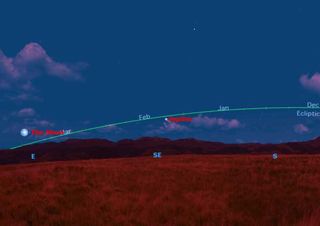See the Special Effects of the Harvest Moon

Whilethe moon is always something special, the harvest moon, visible all of thiscoming week, is the most special of all. It is the subject of everything fromepic poetry to popular songs.
Whatmakes the harvestmoon so special? Mainly it?s the path it?s following this week. The moonalways travels close to the ecliptic, the path of the sun and planets in thesky, but this week the ecliptic is at a particularly shallow angle to thehorizon. The result is that themoon never gets too far above the horizon all night long for a number ofnights in a row, putting it literally ?in your face.?
Thereis a well known but poorly understood optical illusion known as ?the moonillusion,? whereby the moon, when low in the sky, appears much larger than itdoes when high overhead. This really is an illusion, as you can see foryourself by blocking the moon with a finger held at arm?s length: the moon isno bigger on the horizon than overhead.
When themoon is low in the sky, it is also strongly subject to appearing yellow,orange, or red due to air pollution, particularly caused by forest fires thistime of year.
So wehave a? low moon, in your face, artificially enlarged, and often brightlycolored: the famous harvest moon.
Take alook at this illustration. It shows the harvest moon as seen from Calgary,Alberta, at 6 p.m. this Saturday evening. The sun is setting behind you in thewest, and the moon is rising in the east, Jupiter to the southeast. Notice theshallow angle between the ecliptic (in green) and the horizon, typical nearfull moon at this time of year. The effect of this shallow angle is that, eventhough the Moon moves about 12 degrees along the ecliptic every night, itsrising time doesn?t change very much from night to night.
Thismeans a succession of nights with a bright moon low on the eastern horizon,lighting up the land just as the sun sets opposite it. This gives a few extrahours of light to farmers out harvesting their crops. Hence the name: harvestmoon.
Get the Space.com Newsletter
Breaking space news, the latest updates on rocket launches, skywatching events and more!
Theharvest moon, while beautiful to look at, also presents some great ?\photoopportunities. However, if you just take a snapshot of the moon in thelandscape, you may be disappointed. Because the ?moon illusion? doesn?t affecta camera lens, the moon will look small.
If yourcamera has automatic exposure, the scene will look too bright and the moon willbe overexposed. The trick to capturing the harvest moon in a photograph isfirst, to zoom in with your telephoto lens to make the moon appear larger, andsecondly, to underexpose the picture by a couple of stops, to darken thelandscape, saturate the colors, and expose the moon properly. Good luck!
- Gallery:The Moon
- Top10 Amazing Moon Facts
- More Night Sky Features from StarryNight Education
Thisarticle was provided to SPACE.com by Starry Night Education, theleader in space science curriculum solutions.
Join our Space Forums to keep talking space on the latest missions, night sky and more! And if you have a news tip, correction or comment, let us know at: community@space.com.

Geoff Gaherty was Space.com's Night Sky columnist and in partnership with Starry Night software and a dedicated amateur astronomer who sought to share the wonders of the night sky with the world. Based in Canada, Geoff studied mathematics and physics at McGill University and earned a Ph.D. in anthropology from the University of Toronto, all while pursuing a passion for the night sky and serving as an astronomy communicator. He credited a partial solar eclipse observed in 1946 (at age 5) and his 1957 sighting of the Comet Arend-Roland as a teenager for sparking his interest in amateur astronomy. In 2008, Geoff won the Chant Medal from the Royal Astronomical Society of Canada, an award given to a Canadian amateur astronomer in recognition of their lifetime achievements. Sadly, Geoff passed away July 7, 2016 due to complications from a kidney transplant, but his legacy continues at Starry Night.
